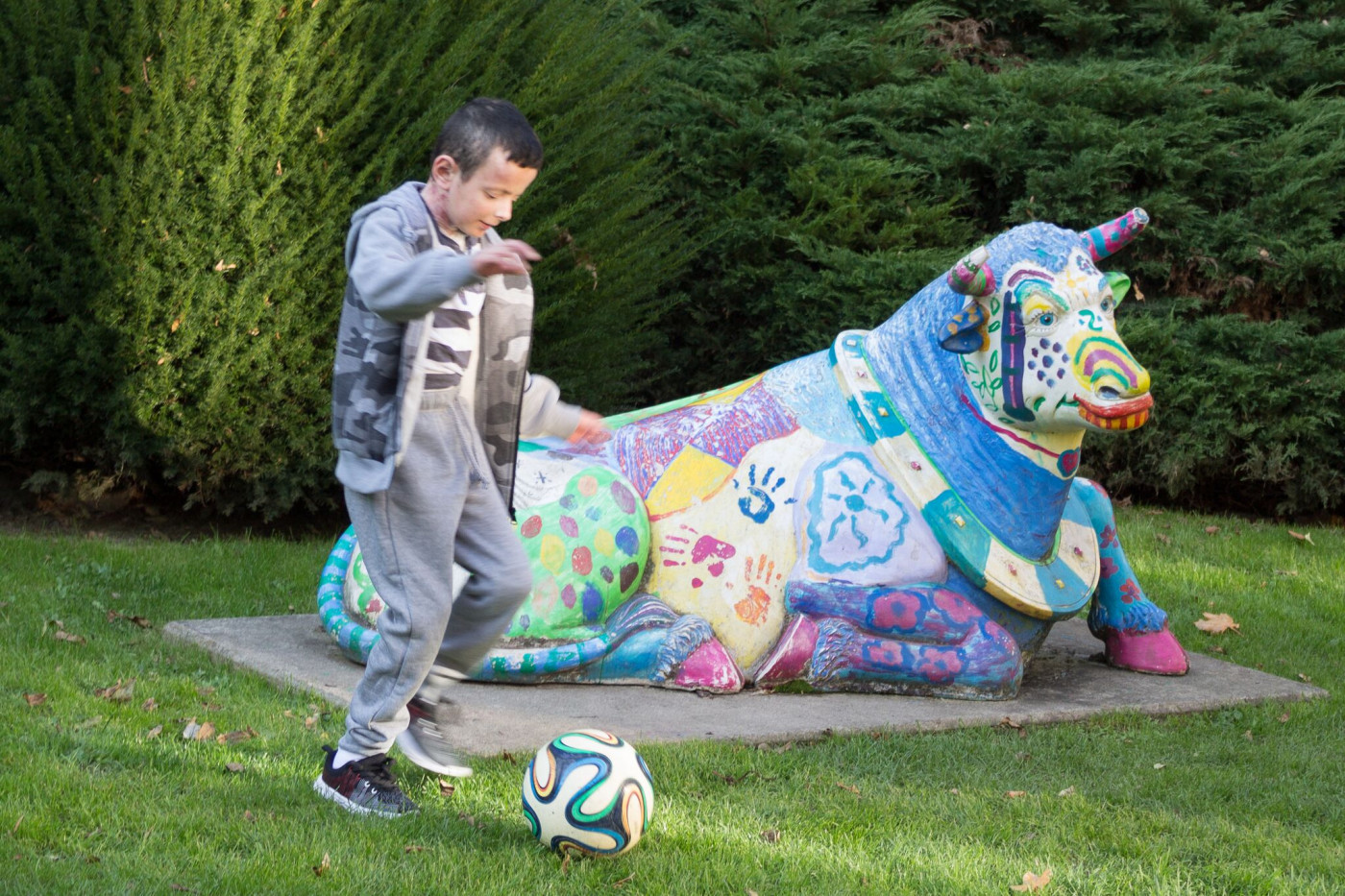‘You See a Miracle’: Interview with Scientists on Gene Therapy That Saved Boy Dying of EB

Hassan playing soccer with his father at the hospital grounds. (Photo courtesy of Ruhr-University Bochum)
A group of physicians and researchers in Germany and Italy were quietly making history in 2015, aware they were doing something extraordinary but refraining from going public. They needed time to ensure their feat — giving a dying boy with epidermolysis bullosa (EB) genetically engineered new skin — would be a success.
By any measure, they succeeded.
The story of 7-year-old Hassan of Germany, his new skin and near-perfect recovery is one of hope, hard work, and seamless collaboration.
“I have never experienced anything else that worked out so well, and I’m a doctor for quite a long time,” Tobias Rothoeft said when Epidermolysis Bullosa News spoke to him about the stem cell therapy given the boy.
Hope, because since the medical team published results of this case this month, EB patients worldwide are asking about the experimental treatment. Rothoeft said requests are coming to team members — including one “12 patients in a package” he got from Saudi Arabia.
Hard work, because this potential EB treatment — developed over decades of testing in the lab and used only on two other people to date by its Italian researchers — is still in small-scale clinical trials. Hassan was treated on a one-time compassionate use approval.
Collaboration because this effort spanned countries, and brought burn-unit physicians and treatment centers together with EB-specialized scientists and desperate parents.
“The problem with this story is it worked out quite well,” Rothoeft said. “I’m honest, it really worked quite well, but we were only allowed to do this as a one-time therapy because the kid was clearly dying.”
More research is required before large-scale trials might begin.
An unlikely turn of events
When Rothoeft first saw Hassan in a hospital’s burn unit, the boy was in a desperate state. He had lost about 60 percent of his epidermis — the outermost skin layer — to junctional EB (one of the disease’s major forms), suffered from severe infections and had developed sepsis, a life-threatening condition.
He continued to deteriorate over the next few days, losing another 20 percent of his skin. Without treatment, his survival chances were “zero,” Rothoeft said.
For a doctor, particularly one working in an intensive care burn unit, this may not be unusual. But as doctors do, the team at the Katholisches Klinikum Bochum in Germany tested all available approaches in a race to save the child’s life.
None worked — not even transplanting healthy skin from the boy’s father, who himself was searching the internet for any possible treatment.
The doctors did much the same thing, searching for scientific literature of experimental work in EB. They found one article of promise. An Italian team had treated an EB patient with a genetically modified skin transplant, with results published in 2006. But that was one study, one patient, and the team had not published additional data for almost 10 years.
With no idea how to interpret that lapse, Rothoeft contacted the Italian researchers, led by Michele de Luca with the Center for Regenerative Medicine at the University of Modena.
“The method seemed to be right, but it was just one case … and no other case,” Rothoeft recalled. “I contacted Michele, and thought he would refuse it or the method was no longer available. I was quite surprised that he offered to give us the skin.”
Desperate time, right
Epidermolysis Bullosa News also spoke with de Luca, who had a simple and straightforward reason for the lapse in testing since that 2006 study. European regulations covering lab-grown cells intended for humans tightened in 2007, requiring processes that brought them to the level of experimental drugs, meaning stem cells now had to be manufactured in certified laboratories under standardized conditions.
This placed the Italians’ work on hold for several years, while they stepped outside of academia to found a company — Holostem — with the facilities and expertise to meet the new rules.
“We had to create a biotech company because the university is not usually able to deal with regulations … on the scale of the pharmaceutical world,” de Luca said.
But by the time Hassan was coming to notice in another part of Europe, de Luca and his team had already resumed small-scale clinical work. They quickly agreed to join the German doctors in a quest to save the child’s life.
Time was scarce, Rothoeft said.
“This kid was in a horrible condition. My whole concern was if he would live long enough to get through the surgical procedure,” he said. “I thought it could work, but [only] if the kid would make it that far.”
Hassan complied, regulatory authorities agreed, and the Italian team prepared skin from biopsy tissue, which was then sent to Germany.
In the summer of 2015, a surgical team at Bochum led by Tobias Hirsch performed a first transplant, covering about 30 percent of Hassan’s body — his flanks and limbs — with new, genetically modified skin. Two more surgeries would follow, covering all but his head, neck, parts of his tummy, one elbow and one knee.
A miracle moment
About a week later, at the first change of dressings, Rothoeft, Hirsch and others realized they were on the verge of performing the first successful large-scale transplant of genetically modified skin cells.
“We pulled away and there was perfectly healthy, though immature, skin,” Rothoeft said. “If you have seen these wounds, you know to expect the wounds for three months. So you pull away the bandages and see this skin — this is the wild moment in this story.
“It was the first time you see a miracle.”
Hassan also began a dramatic improvement. Infections and inflammation resolved, infusions and blood transfusions stopped.
Now, two years later, a video shows Hassan joyfully playing soccer with his family. The only trace of the disease to an outside observer is a somewhat cautious pattern of movement — as if the memories of a time where the slightest injury caused blistering and pain that would not go away lingered in his muscles.
Looking ahead
The boy has clearly regained his health and more, but questions remain. How long will this last? Are complications possible?
Both Rothoeft and de Luca underscored that only time will tell. So far, strong evidence suggests that the new skin will last for a long time — maybe a lifetime.
“In the beginning, we were not even sure if he needed ointment on his skin like kids do when they get skin transplants [for burns]. But he does not even need ointments, the skin supports itself,” said Rothoeft. Hassan also responded to a fresh wound to grafted skin on his back — an accident at school — by healing as naturally as any child.
De Luca also noted that doctors have plenty of experience in transplanting skin on burn victims, including on children needing large-scale transplants using their own stem cells.
His first junctional EB transplant patient, treated in 2005, has so far experienced no complications. And from the perspective of skin — the epidermis basically renews itself every month — 12 years is a long time, he said.
In that patient, and another one treated in the 2000s in a small-scale procedure, analyses show that the genetically altered skin cells are still there, de Luca added.
One worrisome risk with gene therapies in general is that genetically altered cells are prone to reproducing in uncontrolled ways and turning cancerous. Might this hang over in Hassan’s future?
Virtually all patients with severe EB eventually develop skin cancer, de Luca said, because of the ongoing inflammation and damage associated with the disease itself. At the moment, both he and Rothoeft — and others also working in this therapy — share a cautious belief that the transplanted skin, by diminishing inflammation, may actually lower a patient’s cancer risk.
De Luca also underscored that the relationship between genetic alterations and cancer is not straightforward, but is dependent on the type of cells and the disease in question. The molecular work done so far does not support the idea that adding a functional EB gene — in the way the team did — increases the likelihood of cancer later in life.
This treatment is not a cure for EB, the doctors noted, and the mutation that Hassan carries in the LAMB3 gene is more than skin deep. The protein made by LAMB3, in fact, is found in all surface epithelial cells, including those covering mucosal surfaces inside the body, such as the mouth, airways, or urinary duct.
“We were able to cure the skin of this kid, not the entire disease,” de Luca said.
This means that Hassan may still develop internal lesions, although the risk is small. Whether EB patients develop severe internal lesions depends on the specific type of mutation a patient carries — and that did not seem likely in this case, he said.
Hassan’s medical team is hoping to perform a last transplant, on parts of his remaining diseased skin — especially his neck, because Hassan’s been wearing button-down shirts and ties, a “lifestyle choice” that isn’t ideal but hard to explain to a now 9-year-old child, Rothoeft said.
But this surgery could be a bit more difficult because that skin is “healthier,” relatively speaking, than what was treated earlier. Regulatory approval has yet to be given.
Doctors also noted that if new skin lesions appear next to a transplanted area, the stem cells have shown they can migrate small distances to heal a new wound.
From one boy to clinical trials
The next question, of course, is might this therapy actually help others, and on what scale?
De Luca and his team are now working with the University of Salzburg on two Phase 1/2 clinical trials, testing the method in patients with junctional EB — the rare type Hassan had — as well as in the more common recessive dystrophic EB (NCT02984085), which is recruiting up to 12 patients in Austria.
If proven safe and effective in this type of EB — caused by mutations in another protein — de Luca said he and his partners are planning to start larger trials.
They are also exploring better ways of getting a new gene into skin stem cells. “We are trying to address the issue of gene therapy [for] this disease 360 degrees, and it’s not easy,” he said.
Teamwork is what ultimately allowed for Hassan’s happy story and its telling, and that need for essential teamwork will continue.
“This whole endeavor only worked because we had three institutions that worked nearly seamlessly together,” Rothoeft concluded. “This was perfect … quite a good experience.”






